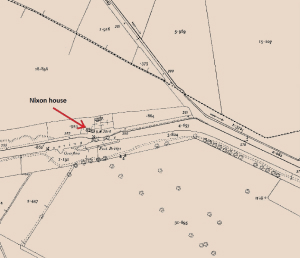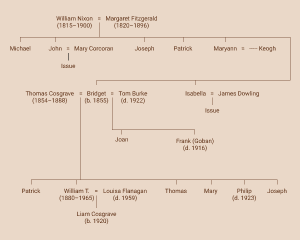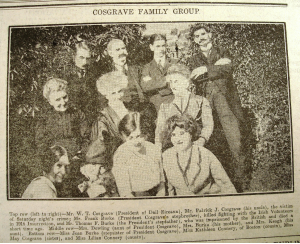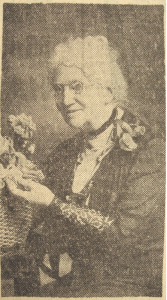Bridget Nixon
Kildare born mother of a President of the Irish Free State government and grandmother of a Taoiseach
Published in The Dublin Historical Record
Bridget Nixon was a native of Landenstown just outside Prosperous, in County Kildare. She was the mother of three sons that took part in the Easter Rising in 1916, with one among the fatalities. A surviving son, W.T. Cosgrave, served as head of the Irish Government from 1922 to 1932.
Bridget was born in 1855 in a picturesque cottage which was situated on the banks of the Grand Canal beside the lockkeeper’s house at the 18th lock in Landenstown.1 She was the daughter of William Nixon who worked as a steward to the Digby family of Landenstown House.2 Her mother was Margaret Fitzgerald who belonged to a well-to-do family from Callan in County Kilkenny.3
William and Margaret married in the mid-1840s. It appears that William who came from a Protestant religious background converted to Catholicism, his wife’s religion at the time of his marriage. It is likely that the couple also moved to Landenstown at this period.
William and Margaret had nine children, four boys and five girls. They were named: Michael, John, Alicia, Joseph, Patrick, Maryann, Isabella, Bridget and Margaret. The Nixon siblings began emigrating to America at an early age. It is known the younger members found it difficult to obtain their fare to America and were assisted financially by older siblings. Isabella, for instance on arriving in America saved the passage fare for one of her younger siblings.4 However, three of the Nixon sisters Maryann, Isabella and Bridget—having spent some time in America returned to live in Ireland. John the second eldest of the family may have resided in the house in Landenstown following his marriage and the birth of his baby in 1868. However, it is likely that he subsequently emigrated to America.5
It is known that Bridget returned to Ireland in her late teens and by 1877 had married Thomas Cosgrave who was a native of Castledermot.6 The Cosgrave family were strong farmers in the area. They had originally lived in County Wexford but relocated to County Kildare following the execution of an ancestor for involvement in the ‘1798 Rebellion’.
Thomas and Bridget set up home in James’s St. in Dublin where Thomas operated as proprietor of a shop and public house opposite the entrance to the South Dublin Union (now James’s St. Hospital). The business prospered and the couple had six children, Patrick; William; Thomas; Mary; Philip and Joseph.7 The second eldest son William who was born in 1880 was named after his maternal grandfather William Nixon. In later life he was better known as ‘W.T.’ the future President of the Executive Council of the Irish Free State. The older children of the family including William spent their holidays with their grandparents at Landenstown. William and Mary would travel by train to Sallins then walk the remainder of the way to Landenstown.8 Thomas Cosgrave in addition to his work as a shopkeeper and publican found time to be involved in local politics serving both as a commissioner on Kilmainham Township and as a member of the Board of Guardians of the South Dublin Union.9
Thomas Cosgrave died suddenly in 1888, at a relatively young age of 34. Bridget who was a year younger found herself a widow with six young children under the age of ten. At the time she was ably assisted by one of her brothers-in-law Patrick Cosgrave who lived nearby. However, he could only give limited assistance as he held a full time position as the town clerk for Kilmainham Township. The business, however, was ably managed by an employee, Tom Burke who was single and slightly younger than Bridget. In 1891, Tom and Bridget were married. Subsequently the public house and the grocery business continued to prosper. They had two children, Joan and Frank, who was better known as Goban, a personal family nickname.10
Two of Bridget’s sisters, Isabella and Maryann also lived in Dublin. Isabella’s husband James Dowling was originally from the Nixon’s home village of Prosperous.11 By the late 1890’s Maryann was living with Bridget in James Sreet and in 1896 she temporary moved back to Landenstown to assist her ailing mother who died later that year. Shortly afterwards William Nixon who had a heart complaint moved to Bridget’s house in James’s St. where he died in January 1900.12
The nationalist-Gaelic revival that had been taken place at this period greatly influenced the Cosgrave-Burke family. In 1906 Bridget’s son William who had become involved in politics, unsuccessfully stood for Sinn Féin in the Dublin Corporation election of 1906. However, in 1911 he was successful and won a seat on the Corporation. The 1911 census show the extent of the family’s nationalism with the entire extended family including Bridget’s sister Mary Keogh filling out all the census details in Irish.13
When the Irish Volunteers were formed in 1913 three of Bridget’s sons William and Philip Cosgrave, and Frank Burke joined. At the outbreak of the rising in 1916 all three reported for duty and served under Commandant Eamon Ceannt, in the South Dublin Union with William serving as a Lieutenant.14 Heavy fighting occurred in the Union complex throughout Easter week with both sides suffering heavy casualties. The sound of continuous gunfire could be heard by Bridget who lived less than fifty yards from the fighting. The Volunteers in the Union held out until Sunday 30th and were the last of the rebel Dublin garrisons to surrender.15
As a mother of Easter Rising participants she paid a heavy price, probably second only to Margaret Pearse. Two of her sons William and Philip, were sentenced to death and reprieved, however, her youngest son, nineteen-year-old Frank, was killed in the fighting. He was at the time buried in the South Dublin Union burial ground.16 Family sources indicate that following the rising he was exhumed and buried in the family burial plot in Goldenbridge Cemetery.
In the aftermath of the rising, Bridget’s husband Tom Burke and her brother-in-law Patrick Cosgrave were both arrested and imprisoned for a short period. With such traumatic events occurring in the Cosgrave-Burke family, it is likely they were assisted spiritually at this time by Fr Thomas Fitgerald OFM who was a close friend of the family and a first cousin to Bridget. Fr Thomas was a well-known writer and later a translator of Patrick Pearse’s works. He got to know the family very well when attached to the Franciscan Friary at Adam and Eves in Dublin.17
Following the release of the Easter Rising prisoners in 1917 both William and Philip continued their involvement in the struggle for independence. The political career of William or W.T. Cosgrave as he is better known during the War of Independence is well documented. He was elected an MP in a by-election in 1917; the following year he was arrested in the German Plot arrests and in 1919 was appointed a member of the cabinet in the first Dáil Éireann. His brother Philip was also involved in the national struggle at this time and was elected a member of the second Dáil in 1921.18 Throughout this period Bridget and the Cosgrave-Burke family continued to live in the public house in James Street and the premises was regularly raided by the Black and Tans. On one night in particular the house was raided three times. As a result, during the most crucial stages of the struggle, William and Philip were forced to go on the run.19
Tom Burke was also giving assistance behind the scenes and was arrested again in 1920. He was imprisoned in Belfast and it had a detrimental effect on his health. He died shortly after his release in early 1922 at a relatively young age of sixty.20
While Bridget was in mourning in early 1922 the British authorities evacuated from the greater part of the country and the Civil War began. In August 1922 her son William was appointed head of the new Irish Government following the death of Michael Collins.
The family pub and shop in James Street continued to trade with Bridget’s brother-in-law Patrick Cosgrave, now retired, assisting. However, the autumn of 1922 was a period of lawlessness and the public house was raided by an armed gang in mid-September. The following week on the night of the 30th of September the premises was raided again and Patrick Cosgrave was shot dead by the intruders.21 It is believed that the perpetrators falsely represented themselves as anti-Treaty Irregulars but were really a gang that was active at the time in raiding public houses at closing time usually on Saturday nights.22
Before the end of the following year Bridget was to suffer yet another untimely bereavement. In December 1923 her son Philip, who had just been re-elected to the Dáil with a substantial vote, died suddenly from natural causes.23 He was unmarried and living with his mother at the time.
Bridget at this point decided to move from the public house in James Sreet and in 1924 purchased a house in Landensdown Road from Dr Richard Hayes TD who was a family friend.24 There she lived quietly until her death on the 17th of January 1934.25 She was interred in the family burial plot in Goldenbridge Cemetery, Inchicore.
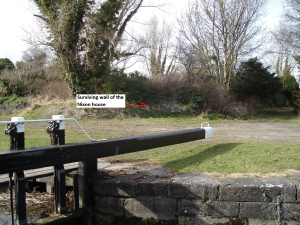
Nixon house ruins at Landenstown.
Showing a portion of a surviving wall at the 18th Lock, Grand Canal.
During the period of the Irish Revolution from 1916 to 1923, there were few Irishwomen called on to endure more than Bridget Nixon. Throughout her adult life on at least eight occasions she suffered either tragic or untimely family deaths. Today the site of her birth remains a pleasant beauty spot on the banks of the Grand Canal just outside Prosperous Village. Members of the public, enjoying the country tranquillity of the site are unaware of the lady who once spent her youth in that pleasant and peaceful part of County Kildare.
Footnotes
- National Library of Ireland (NLI) Church records; Details of the location of the house from personal communication with Billy Fitzpatrick, Currabell, Prosperous.
- Civil Registration Office, Death certificate; National Archives of Ireland (NAI), Cosgrave Family Papers.
- NLI, Church records. A search of Catholic Church records from Callan Co. Kilkenny show a Margaret Fitzgerald born in 1822 to William Fitzgerald and Bridget Phelan of Green St, Callan.
- Detail from personal communication with Mrs Maureen Sweeney, Stillorgan, Dublin.
- Search of records in Ireland show no Nixon of that name in the 1901 census.
- Thom’s Directory 1877, show that Patrick Cosgrave possessed the premises in Thomas St. According to family tradition Bridget married aged 17.
- NAI, Cosgrave family papers.
- Detail from personal communication with Liam Cosgrave.
- Thoms Directory
- Anthony J Jordan, WT Cosgrave, 1880–1965: Founder of Modern Ireland (Dublin, 2006).
- James was the son of Edward Dowling from Ballinafagh near Prosperous.
- Civil Records Office (CRO) Death certificate.
- NAI, 1911 census.
- Eamonn Ceannt was O/C of the 4th Battalion, Irish Volunteers and all three were members of this Battalion.
- Charles Townshend, Easter Week 1916: the Irish Rebellion (London, 2005), pp 246–250
- Kildare Observer, May 1916; The staff of the Union opened a temporary burial ground to provide for those killed in the grounds and there were at least 14 internments. They included, Volunteers, British soldiers and civilian personnel of the Union. One of the burials which occurred following the ending of hostilities was of a middle-aged volunteer who was recognised just prior to burial by his son, a serving British soldier in the Royal Dublin Fusiliers. The South Dublin Union Cemetery is within the confines of James’s St. Hospital.
- Detail relating to Fr Fitzgerald from the Franciscan archive. My Thanks to Fr. Ignatius Fennessy OFM.
- Jordan, WT Cosgrave, 1880–1965.
- Irish Independent (II), Jan. 1934
- CRO. Death Certificate; Freemans Journal (FJ), Sept 1922.
- FJ, Oct. 1922.
- New York Times, 2 October 1922.
- FJ, 21 Dec 1923.
- According Thoms Directory, 8 Landsdown Rd, was held by Richard Hayes TD in 1924 and Bridget Burke in 1925.
- II, 18 Jan 1934.

